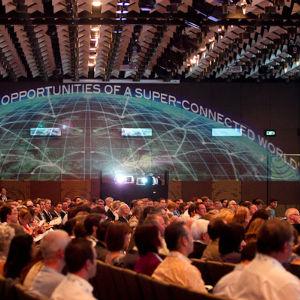The global economy swings between signs of recovery and predictions of imminent collapse. Businesses appear paralysed. Though many are cash-rich, they’re risk-averse, strategically incremental and lacking in fresh ideas and innovation.
The world needs leadership, invention and daring now more than ever. We need audacity not austerity. We need to attack big, wicked, problems that improve the economy and society as a whole. We need bold ideas that represent real business opportunities that spark a revolution for courage and change.
Our world faces incredible challenges. We live in a world full of surprises – there is something about technology that takes us ever closer to the margins than we could go before: drilling oil deeper, taking greater risks within banking, having more planes in the air. When things go wrong and the oil leaks, or the finance sector collapses, or volcanic ash clouds block our skies, they go very wrong.
Inevitably as technology progresses our risks will deepen, and our lives in this new millennium will be, as they already are, filled with very large surprises. We face the certainty of uncertainty. Individuals and organisations need creative new ideas and innovative solutions to adapt to constant change and re-invent the future.
Creativity is of increasingly strategic value to nations, communities and individuals in making the transition to innovation and knowledge-based economies. Creativity and innovation are also vital for businesses exposed to globalisation, increasing competition, diversity among consumers and rapidly changing technology. Tomorrow’s competitive success will be based on creative ideas.
The development of people who can imagine and create innovative new solutions is the key to future success and sustainability. The recent IBM CEO Global Study, which surveyed 1500 CEOs, identified creativity as the most important leadership attribute over the next 5 years in an increasingly complex global environment. The study is the largest known sample of one-on-one CEO interviews, with over 1,500 corporate heads and public sector leaders across 60 nations and 33 industries polled on what drives them in managing their companies in today’s world.
Creative Leadership has been defined as the ability to shed long-held beliefs and come up with original and at times radical concepts and execution. And this requires bold, breakthrough thinking. It is not accepted that this isn’t about having a lone creative leader at the top but rather about creating a “field” of creative leadership, by igniting the collective creativity of the organization from the bottom up. In essence, creative leaders excel at creating creative leaders.
The IMB report identifies a group of standout organizations which delivered solid business results even during the recent downturn. Their revenue growth was six times higher than the rest of the sample and they plan to get 20% of revenues from new sources in the near future.
How do these firms succeed? These top performers focus on developing creative leaders across their organizations, deepening partnerships with employees and customers and achieving operational agility. Creative leaders in these firms are more prepared and willing to make deeper business model changes to realize their strategies. To win, they take more calculated risks and keep innovating in how they lead and communicate. They are ready to upset the status quo even if it is successful and are committed to ongoing experimentation with disruptive business solutions.
Changing the work culture, unlearning and selectively forgetting past success formulas, and co-creating future products and services with employees, customers, and external partners are hallmarks of creative leaders in organizations from the US, Europe, and Asia. Firms exhibiting creative leadership out-performed their competition during the recession.
Creative leadership is a priority in these increasingly complex and volatile times. To be a leader today you require a whole different set of tools and thinking. Unfortunately, our education system has not taught us how to think “outside the box”.
Due to the fact that creative thinking is generally not part of our education curriculum, often people lack confidence in their creative ability. We are all creative beings and if we can remove our self-limiting beliefs about our own creativity then we can develop this important capability. Creativity is the process of having original ideas that have value. It is a process and it’s not random. Furthermore, it can be learnt. As Edward de Bono said: “Creative thinking is not a talent, it is a skill that can be learnt. It empowers people, adding strength to their natural abilities, which improves teamwork, productivity, and where appropriate, profits.”
Creativity and innovation are a core competency for leaders and managers. We need to teach people how to perceive the world in new ways, to find hidden patterns, to make connections between seemingly unrelated phenomena, to ask important questions and to generate solutions. Generating fresh solutions to problems, and the ability to create new products, processes or services for a changing market and new world are part of the intellectual capital that gives a company its competitive edge. Creativity is a crucial part of the innovation equation.





